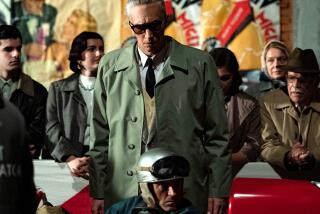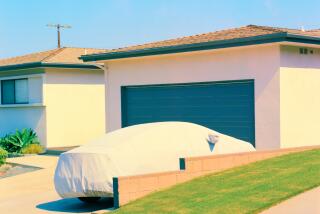Review: Ricardo Valverde at Vincent Price museum: Fresh look at a probing eye
A black-and-white video near the end of a retrospective of photographically based work by Ricardo Valverde (1946-1998) shows both the provocation and the conundrum that his work offers. Projected on a wall at the Vincent Price Art Museum at East Los Angeles College, “Freeway Dream” (circa 1973-1976) tracks a car’s movements on an open L.A. freeway. A lovely, 8 ½-minute automotive meditation, it’s as if the car were a chariot of the gods.
Wide-open and freewheeling, with no particular end in sight, the pleasurable if mundane world simply unfolds. Shooting out the window, the camera turns to document nothing more noteworthy than the road that has been passed, stretching out behind the gliding vehicle. Cars pass or are passed, the landscape rushing by.
At one point the camera rises, sneaking up on an empty, abandoned sports car oddly parked on the freeway shoulder. What happened remains a mystery, modest and soon forgotten.
Elsewhere Valverde points his camera down at the passing pavement. The chimerical image of his own car’s shadow remains fixed and motionless, while the world beneath it hurries by.
In the gallery the projected video image is bleached out and pale, occasionally fuzzing and jittering. Perhaps the technical imperfection is intentional, or perhaps it’s a legacy of the unreliability of early videotape. (Valverde made the work while still a student; he received his UCLA master’s in graphic design in 1976.) Either way, it adds to his art’s engagingly casual aura of taking things as they come.
“Freeway Dream” is documentary, without a fabricated narrative or planned development. Valverde records the very familiar, rather than the remote or unacknowledged subjects that traditional documentary photographs so often mean to bring to wider attention. That he does it through a curious and probing eye serves to make the overlooked seem strange and beautiful.
The video recalls the work of Ed Ruscha -- specifically his 1966 book of still photographs made while driving the Sunset Strip, which put documentary camera-perception on wheels. Before then, from Paris and Prague to New York and San Francisco, street photography was virtually always made by photographers on foot.
L.A.’s car culture demanded something different. Valverde used the portable video camera – then still a new technology for artists – to push automotive street photography out onto the freeway.
Cars, including Chicano lowriders, occupied a special place. The show’s most beautiful still photograph, which exists in hand-colored and black-and-white versions, is “Boulevard Night” (1979), juxtaposing a young woman and a gleaming car on a warm summer evening.
She has just turned her head, as if casually noticing the photographer’s presence, to look directly into the camera’s lens. A pack of Marlboro cigarettes is idly cradled in one hand. Dark, sloe-eyed makeup traces a long, sleek, streamlined path of black eyeliner that mimics the flame-licked paint and light reflections of the car parked behind her.
The show includes about 130 prints, Polaroids, slides, negative transfers and photographic collages that are painted, stapled and scratched, plus several videos, three ceramic sculptures and assorted ephemera. Many are presented as experimental, but more often they feel sketchy and unfinished. And one wonders whether there is a relationship to the experimental photographic work of Robert Heinecken, who taught at UCLA when Valverde was a student there.
A lengthy slide show chronicles correspondences between loud, colorful, big-ticket corporate logos used in street advertising with loud, colorful and homemade street graffiti. But individual images don’t seem to add much to the work’s general observation about social organization in a familiar public combat driven by economic power.
Works like “Boulevard Night” and “Freeway Dream” demonstrate what Valverde was capable of producing. (A brain tumor, diagnosed when he was barely 38, cut his life short at 52.) He used the camera, both still and video, as pencil and paper with which to take notes. On occasion the insight was penetrating.
The retrospective was organized by guest curator Cecilia Fajardo-Hill, formerly a curator at the Museum of Latin American Art in Long Beach. Valverde’s work was included there in “Mex/LA: Mexican Modernism(s) in Los Angeles, 1930-1985,” a 2011 group show that was part of Pacific Standard Time.
Not well-known, he is also the subject of a slim volume by Ramon Garcia, published last year under the auspices of the UCLA Chicano Studies Research Center. (The retrospective has no catalog.) On the evidence, Valverde is not a major rediscovery, but he is an artist worth knowing more about – a need this show admirably begins to fill out.
Vincent Price Art Museum, 1301 Avenida Cesar Chavez, Monterey Park, (323) 265-8841, through July 26. Closed Sunday and Monday www.vincentpriceartmuseum.org
Twitter: @KnightLAT
More to Read
The biggest entertainment stories
Get our big stories about Hollywood, film, television, music, arts, culture and more right in your inbox as soon as they publish.
You may occasionally receive promotional content from the Los Angeles Times.







